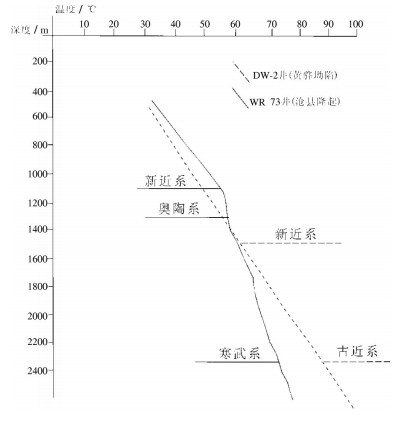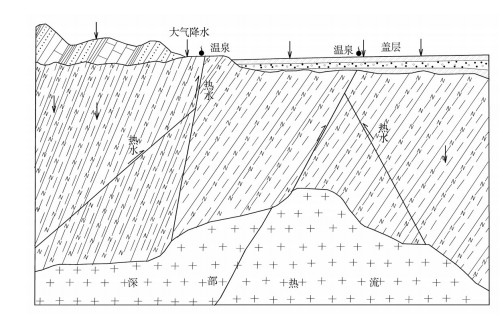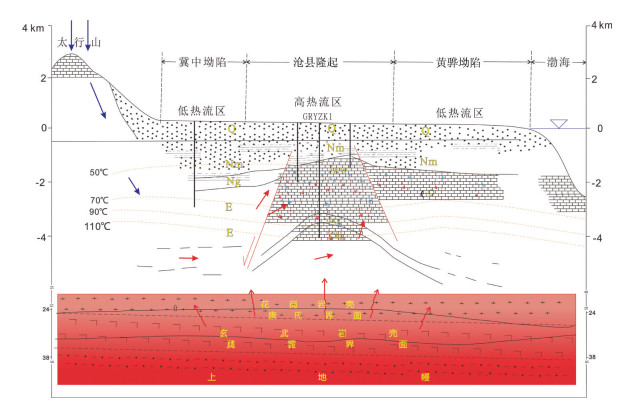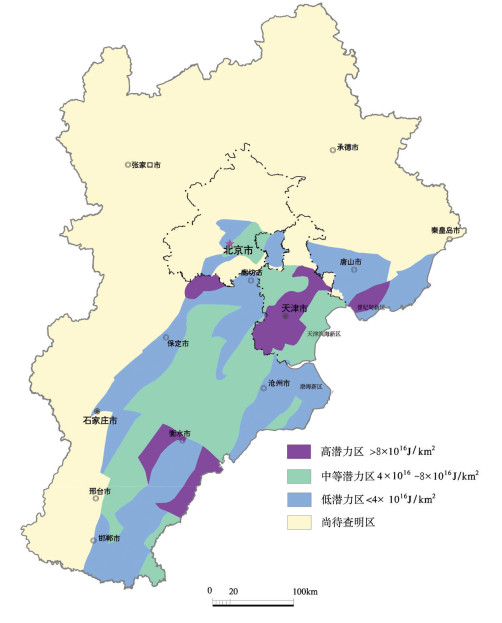Research on formation mode and development potential of geothermal resources in Beijing-Tianjin-Hebei region
-
摘要:
京津冀地区雾霾较为严重,同时地热资源丰富,因此,充分利用地热资源是调整该地区能源结构,减缓雾霾的重要途径之一。本文在分析京津冀地区构造、大地热流、地温梯度等地质背景的基础上,分别总结了京津冀地区隆起山地对流型与沉积盆地传导型地热资源的成藏模式与赋存条件,并对两种地热资源的资源量、开发利用现状与潜力进行了分析。京津冀地区地热资源储量折合标准煤约1383亿t,年地热流体可开采热量折合标准煤1100万t,但目前地热流体年开采热量仅相当于114万t标准煤,约占总量的10%,开发利用潜力巨大。
Abstract:Haze in Beijing-Tianjin-Hebei region is relatively heavy; at the same time, this region is rich in geothermal resources. The development of geothermal resources can contribute to the energy structure adjustment and the control of haze in that region. In this paper, based on the analysis of the fracture, strata, terrestrial heat flow and geothermal gradient of Beijing-Tianjin-Hebei region, the authors summed up the formation mode and hosting conditions of convection geothermal and conductive geothermal resources respectively. The quantity, exploitation situation and the development potential of geothermal resources were also calculated. The result shows that geothermal resource reserves are equivalent to about 138.3 billion tons of standard coal, and heat in geothermal fluid of the local region amounts to about 11 million tons of standard coal. Nevertheless, the exploitation quantity is only equivalent to about 10% of the total resources, and hence the potential for geothermal resources development and utilization is huge.
-
Key words:
- Beijing-Tianjin-Hebei region /
- North China Plain /
- geothermal resources /
- formation mode
-

-
表 1 京津冀地区地热资源量评价结果一览
Table 1. Evaluation result of geothermal resources in Beijing-Tianjin-Hebei region

-
Bin Dezhi, Liu Jiurong, Wang Xiaoling. 2002. Geothermal resources in Beijing[C]//Beijing Geothermal International Symposium (in Chinese with English abstract).
Chen Moxiang, Wang Jiyang. 1994. Geothermal Resources in China:Formation Characteristics and Potential Assessment[M]. Beijing:Sciences Press, 1-39 (in Chinese with English abstract).
Chen Moxiang. 1988. Geothermal Resources in North China[M]. Beijing:Science Press, 1988:1-214 (in Chinese).
Cui Baole. 2010. Study on the development of hot spring tourism in Bazhou in the the Beijing-Tianjin-Hebei economic integration process[C]//Comprehensive Docking in the Same City and the Beijing-Tianjin Corridor Economic Integration Academic Conference (in Chinese).
Fang Lianyu, Li Jun, Kang Puqing. 2015. Report of geothermal resources evaluation and regionalization in Hebei Province[R]//HengShui, The Third Party of Hydrogeology and Engineering Geology, Hebei Bureau of Geology and Mineral Investigation. 6.10.(in Chinese)
Gong Yuling, Wang Liangshu, Liu Shaowen, Ye Tengfei. 2011.Thermal structure and thermal evolution of the Bohai Basin in Eastern China.25-42 (in Chinese).
http://onlinelibrary.wiley.com/doi/10.1002/gj.2693/abstract Hu Shengbiao, He Lijuan, Wang Jiyang. 2001. Compilation of heat flow data in the China continental area (3rd edition)[J]. Chinese Journal of Geophysics. 44 (5):611-626 (in Chinese with English abstract). http://en.cnki.com.cn/Article_en/CJFDTOTAL-DQWX200105004.htm
Jiang Ling. 2015. Energy Consumption Structure and Carbon Footprint Analysis of Beijing-Tianjin-Hebei[D]. Tianjin:Tianjin University. (in Chinese with English abstract).
https://www.researchgate.net/publication/313488760_Decomposition_Analysis_of_Energy_Efficiency_in_China%27s_Beijing-Tianjin-Hebei_Region Li Gongke, Wang Weixing, Li Hong, Yang Fengtian, Wang Linhai, Fang Wanling. 2014. Temperature distribution and controlling factors of the Tangquan geothermal field in Hebei Province[J]. Geology in China, 41(6):2099-2109(in Chinese with English abstract). http://www.researchgate.net/publication/287067321_Temperature_distribution_and_controlling_factors_of_the_Tangquan_geothermal_field_in_Hebei_Province
Li Ningbo, Yang Junwei, Yu yuan, Li Xiang, Ke bolin. 2017.Combination with development and innovation for efficient use of "Two Geothermal"in Beijing-Taijin-Hebei economic zones[J]. Urban Geology, 12(1):1-4 (in Chinese with English abstract). http://www.en.cnki.com.cn/Article_en/CJFDTotal-CSDZ201701002.htm
Lin Li, Gao Baozhu, Ruan Chuanxia. 2014. Report of geothermal resources evaluation and regionalization in Tianjin[R]//Tianjin, Tianjin Geothermal Exploration and Development-Designing Institute, 10 (in Chinese).
Lin Li, Zhao Sumin, Wang Xinyi. 2006. Utilization state and protection project in Tianjin Geothermal Area[J]. Editorial Board of Journal of HPU (Nature Science), 25(2):105-110(in Chinese with English abstract). http://en.cnki.com.cn/Article_en/CJFDTOTAL-JGXB200602006.htm
Lin Wenjing, Liu Zhiming, Wang Wanli, Wang Wanli. 2013. The assessment of geothermal resources potential of China[J]. Geology in China, 40 (1):312-320(in Chinese with English abstract). http://www.researchgate.net/publication/286072143_The_assessment_of_geothermal_resources_potential_of_China
Liu Jie, Song Meiyu, Tian Guanghui. 2012. Discussion on the orebearing characters of the Jiaoyuan Fault in Songxian County, Henan Province[J]. Geological Survey and Research, 67-73 (in Chinese with English abstract).
Liu Kai, Liu Yingchao, Sun Ying, Liu Jiurong, Wang Shufang, Liu Zongming. 2015. Characteristics of deuterium excess parameters of geothermal water in Beijing[J]. Geology in China, (6):2029(in Chinese with English abstract). https://link.springer.com/article/10.1007/s12665-016-6285-y
Liu Xun, You Guoqing. 2015. Tectonic regional subdivision of China in the light of plate theory[J].Geology in China, 42(1):1-1(in Chinese with English abstract). http://en.cnki.com.cn/Article_en/CJFDTotal-DIZI201501001.htm
Ma Fengru, Lin Li, Wang Yingping, Cheng Wanqing, Zhao Sumin. 2006. Discussion on the sustainable exploitation and utilization of geothermal resources in Tianjin[J]. Geological Survey and Research. 29(3):222-228 (in Chinese with English abstract). http://en.cnki.com.cn/Article_en/CJFDTOTAL-QHWJ200603008.htm
Qiu Nansheng, Hu Shengbiao, He Lijuan. 2004. Theory and Application of Study on Geothermal Regime of Sedimentary Basin[M]. Beijing:Petroleum Industy Press, 26-29 (in Chinese).
Sun Ying, Liu Kai, Liu Jiurong. 2015. Report of Geothermal Resources Evaluation and Regionalization in Beijing[R]. Beijing, Beijing Institute of Hydrogeology and Engineering Geology. 6(in Chinese).
http://en.cags.ac.cn/AboutCAGS/Institute/HE/Major/9750.htm Tian Tingshan, Li Minglang, Bai Ye. 2006. Geothermal sources in China and its exploration[M]. Beijing:China Environmental Science Press. (in Chinese).
Tian Guanghui, Lin Li, Cheng Wanqing, Zeng Meixiang, Liu Donglin, Song Meiyu, Cai Yun, Wang Ping, Zong Zenghai. 2011. The construction of dynamic monitoring network for the development and utilization of shallow geothermal energy in Tianjin[J]. Geology in China, 38(6):1660-1666. (in Chinese with English abstract). http://en.cnki.com.cn/Article_en/CJFDTOTAL-DIZI201106028.htm
Wang Guiling, Zhang Wei, Liang Jiyun, Lin Wenjing, Liu Zhiming, Wang Wanli. 2017. Evaluation of geothermal resources potential in China[J]. Acta Geoscientica Sinica, 38(4):448-459. (in Chinese with English abstract). http://www.en.cnki.com.cn/Article_en/CJFDTOTAL-DQXB201704002.htm
Wang Jiyang, Hu Shengbiao, Pang Zhonghe, He Lijuan, Zhao Ping, Zhu Chuanqing, Rao Song, Tang Xiao-yin, Kong Yanlong, Luo Lu, Li Weiwei. 2012. Estimate of geothermal resources potential for hot dry rock in the continental area of China[J]. Science and Technology Review, 2012, 30(32):25-31(in Chinese with English abstract). http://www.researchgate.net/publication/273320918_Estimate_of_Geothermal_Resources_Potential_for_Hot_Dry_Rock_in_the_Continental_Area_of_China
Wang liangshu, Liu Shaowen, Xiao Weiyong, Li Cheng, Li Hua, Guo Suiping, Liu Bo, Luo Yuhui, Cai Dongsheng. Distribution characteristics of terrestrial heat flow in Bohai Basin (in Chinese).
Wang Wanli, Zhu Xi, Wang Guiling. Method of forecasting the temperature in constant temperature zone under warm temperate climates[J]. Renewable Energy Resources, 2016, 34(8):1112-1116(in Chinese with English abstract). https://www.sciencedirect.com/science/article/pii/S0380133009001403
Wang Weixing, Li Gongke, Li Hong, Hou Jiayu, Fang Wanling, Yang Fengtian. Hydrogeochemical characteristics and origin of the geothermal fluid in Tangquan area, Hebei Province[J]. Geology in China, 2013, 40(6):1935-1941(in Chinese with English abstract). http://www.researchgate.net/publication/286989709_Hydrogeochemical_characteristics_and_origin_of_the_geothermal_fluid_in_Tangquan_area_Hebei_Province
Wang Xuegong, Li Yongzhuang. 2001. Characteristics and evaluation of geothermal resources in Beijing-Tianjin-Hebei Region[J]. Geothermal Energy, (6):1-7 (in Chinese). https://link.springer.com/chapter/10.1007/978-3-662-46205-8_4
Wang Yang, Wang Jiyang, Deng Jinfu, Xiong Liangping. 2001. Heat flow constraint on the abundance of uranium, thorium and potassium in crust and lithosphere of the continental area of China[J]. Progress in Geophysics, 16(3):21-30 (in Chinese with English abstract). http://en.cnki.com.cn/Article_en/CJFDTOTAL-DQWJ200103002.htm
Wang Zhigang. 2016. Discussion on energy saving measures for atmospheric and vacuum distillation unit[J]. Green Petroleum & Petrochemicals, 1(6):1-5 (in Chinese with English abstract). http://www.digitalrefining.com/article/1001214,Energy_conservation_in_a_crude_unit.html
Wang Zuwei. 2000. The Development countermeasure of Tianjin terrestrial heat resources[J]. Territory & Natural Resources Study, (3):50-51(in Chinese with English abstract). http://en.cnki.com.cn/Article_en/CJFDTOTAL-GTZY200003016.htm
Wei Wanshun. 2010. Evaluation of Shallow Geothermal Energy Resources[M]. Beijing:China Earth Publishing House (in Chinese).
Zheng Liying. 2015. The Characteristics and Evaluation of Geothermal Resources in Beijing-Tianjin-Hebei Region[D]. Beijing:China University of Geosciences (in Chinese with English abstract).
https://link.springer.com/chapter/10.1007/978-3-662-46205-8_4 Zheng Xiaoxia, Li Lingjun, Zhao Wenji, Zhao Wenhui. 2014. Spatial and temporal characteristics of atmospheric NO2 in the BeijingTianjin-Hebei Region[J]. Ecology and Environmental Sciences, (12):1938-1945 (in Chinese with English abstract). http://en.cnki.com.cn/Article_en/CJFDTotal-TRYJ201412008.htm
Zhu Rixiang, Xu Yigang, Zhu Guang, Zhang Hongfu, Xia Qunke, Zheng Tianyu. Destruction of the North China Craton. Sci China Earth Sci, 2012, doi:10.1007/s11430-012-4516-y.
Zhou Guofu, Gong Lili. 2014. Factor analysis of carbon footprint of Beijing Tianjin Hebei Province energy consumption and influence[J]. On Economic Problems, (8):27-31 (in Chinese with English abstract). http://en.cnki.com.cn/Article_en/CJFDTOTAL-JJWT201408008.htm
Zheng Keyan, Dong Ying. 2009. Bring superiority of geothermal resources into full paly and promote the renewable energy construction in China[C]//Geothermal Symposium of West Pacific branch of 2009 International Geothermal Association(in Chinese).
Zheng Zhizhong. 2017. Study on the characteristics of hydrothermal geothermal resources[J]. Energy & Environment, (1):54-55(in Chinese). http://www.jnr.ac.cn/EN/Y2015/V30/I7/1210
Zhou Zongying, Liu Shiliang, Liu Jinxia. 2015. Study on the characteristics and development strategies of geothermal resources in China[J]. Journal of Natural Science, (7):1210-1221. (in Chinese with English abstract). http://www.arts.cornell.edu/poverty/kanbur/China'sGrowthStrategies.pdf
Zhang Guobin. 2006. Geothermal resource distribution and existing problems in exploitation and utilization[J]. Coal Geology of China, (s1):25-27(in Chinese with English abstract). http://en.cnki.com.cn/Article_en/CJFDTotal-ZGMT2006S1010.htm
宾德智, 刘久荣, 王小玲. 2002. 北京地热资源[C]//北京地热国际研讨会论文集.
陈墨香. 1988.华北地热[M].北京:科学出版社, 1-214.
陈墨香, 汪集旸. 1994.中国地热资源——形成特点和潜力评估[M].北京:科学出版社, 1-39.
崔宝乐. 2010. 京津冀经济一体化过程中霸州市温泉旅游业发展研究[C]. 同城全面对接暨京津廊经济一体化学术会议.
http://cpfd.cnki.com.cn/Article/CPFDTOTAL-LFYY201008001008.htm 方连育, 李郡, 康清普. 2015. 河北省地热资源现状调查评价与区划报告[R]. 衡水, 河北省地矿局第三水文工程地质大队, 6. 10.
龚育龄, 王良书, 刘绍文, 叶腾飞. 2011.中国东部渤海湾盆地热结构和热演化[M].北京:中国原子能出版社, 25-42.
胡圣标, 何丽娟, 汪集旸. 2001.中国大陆地区大地热流数据汇编(第三版)[J].地球物理学报, 44 (5):611-626. http://doi.wanfangdata.com.cn/10.3321/j.issn:0001-5733.2001.05.005
江玲. 2015. 京津冀地区能源消费结构与碳足迹分析[D]. 天津: 天津大学, 2015.
http://d.g.wanfangdata.com.cn/Thesis_Y3174733.aspx 李攻科, 王卫星, 李宏, 杨峰田, 王林海, 房万嶺. 2014.河北汤泉地热田地温场分布及其控制因素研究[J].中国地质, 41(6):2099-2109. http://geochina.cgs.gov.cn/ch/reader/view_abstract.aspx?file_no=20140623&flag=1
李宁波, 杨俊伟, 于湲, 李翔, 何柏林. 2017.开放与创新结合促进京津冀地热"两能"发展[J].城市地质, 2017, 12(1):1-4. http://www.landscape.cn/special/news/xiongan/index.html
林黎, 高宝珠, 阮传侠. 2014. 天津市地热资源现状调查评价与区划[R], 天津, 天津地热勘查开发设计院, 10.
林黎, 赵苏民, 王心义. 2006.天津地热水开发利用状况及保护对策研究[J].河南理工大学学报(自然科学版), 25(2):105-110. http://www.cqvip.com/QK/91634B/200602/22011609.html
刘凯, 刘颖超, 孙颖, 刘久荣, 王树芳, 刘宗明. 2015.北京地区地热水氘过量参数特征分析[J].中国地质, (6):2029. http://geochina.cgs.gov.cn/ch/reader/view_abstract.aspx?file_no=20150629&flag=1
蔺文静, 刘志明, 王婉丽, 王贵玲. 2013.中国地热资源及其潜力评估[J].中国地质, 40(1):312-320. http://geochina.cgs.gov.cn/ch/reader/view_abstract.aspx?file_no=20130121&flag=1
刘杰, 宋美钰, 田光辉. 2012.天津地热资源开发利用现状及可持续开发利用建议[J].地质调查与研究, 2012(1):67-73. http://www.cqvip.com/QK/92839A/200610/23108314.html
刘训, 游国庆. 2015.中国的板块构造区划[J].中国地质, 42(1):1-17. http://geochina.cgs.gov.cn/ch/reader/view_abstract.aspx?file_no=20150101&flag=1
马凤如, 林黎, 王颖萍, 程万庆, 赵苏民. 2006.天津地热资源现状与可持续性开发利用问题[J].地质调查与研究, 29(3):222-228. http://www.wenkuxiazai.com/doc/c5539e52a32d7375a41780d3-2.html
邱楠生, 胡圣标, 何丽娟. 2004.沉积盆地热体制研究的理论与应用[M].北京:石油工业出版社, 2004:26-29.
孙颖, 刘凯, 刘久荣. 2015. 北京市地热资源现状调查评价与区划报告[R]. 北京, 北京市水文工程地质大队, 6.
田光辉, 林黎, 程万庆, 曾梅香, 刘东林, 宋美珏, 蔡芸, 王平, 宗振海. 2011.天津市浅层地热能开发利用动态监测网建设[J].中国地质, 38(6):1660-1666. http://geochina.cgs.gov.cn/ch/reader/view_abstract.aspx?file_no=20110627&flag=1
田廷山, 李明朗, 白冶. 2006.中国地热资源及开发利用[M].北京:中国环境科学出版社.
王贵玲, 张薇, 梁继运, 蔺文静, 刘志明, 王婉丽. 2017.中国地热资源潜力评价[J].地球学报, 38(4):448-459. http://kns.cnki.net/KCMS/detail/detail.aspx?filename=dqxb201704002&dbname=CJFD&dbcode=CJFQ
王良书, 刘绍文, 肖卫勇, 李成, 李华, 郭随平, 刘波, 罗毓辉, 蔡东升.2002.渤海盆地大地热流分布特征[J].科学通报, 47(2):151-155. http://kns.cnki.net/KCMS/detail/detail.aspx?filename=kxtb200202018&dbname=CJFD&dbcode=CJFQ
王婉丽, 朱喜, 王贵玲.暖温带地区恒温层温度的预测方法[J].可再生能源, 2016, 34(8):1112-1116. http://www.docin.com/p-1718708364.html
王卫星, 李攻科, 李宏, 侯佳渝, 房万嶺, 杨峰田. 2013.河北汤泉地热流体水文地球化学特征及其成因[J].中国地质, 40(6):1935-1941. http://geochina.cgs.gov.cn/ch/reader/view_abstract.aspx?file_no=20130622&flag=1
汪集旸, 胡圣标, 庞忠和, 何丽娟, 赵平, 朱传庆, 饶松, 唐晓音, 孔彦龙, 罗璐, 李卫卫. 2012.中国大陆干热岩地热资源潜力评估[J].科技导报. http://kns.cnki.net/KCMS/detail/detail.aspx?filename=kjdb201232017&dbname=CJFD&dbcode=CJFQ
汪洋, 汪集旸, 邓晋福, 熊亮萍. 2001.中国大陆地壳和岩石圈铀、钍、钾丰度的大地热流约束[J].地球物理学进展, 16(3):21-30. http://kns.cnki.net/KCMS/detail/detail.aspx?filename=dqwj200103002&dbname=CJFD&dbcode=CJFQ
王志刚. 2016.地热将成为我国非化石能源增量的主力——京津冀地区地热资源潜力及开发利用设想[J].石油石化节能与减排, 1(6):1-5. http://kns.cnki.net/KCMS/detail/detail.aspx?filename=wzsh201606001&dbname=CJFD&dbcode=CJFQ
王祖伟. 2000.天津市地热资源利用现状及发展对策[J].国土与自然资源研究, 2000(3):50-51. http://kns.cnki.net/KCMS/detail/detail.aspx?filename=gtzy200003016&dbname=CJFD&dbcode=CJFQ
王学工, 李永壮. 2001.京津冀地区地热特征及资源评价[J].地热能, 2001(6):1-7. http://www.cnki.com.cn/Article/CJFDTotal-CSDZ201701011.htm
卫万顺. 2010.浅层地温能资源评价[M].北京:中国大地出版社, 2010.
张国斌. 2006.河北省地热资源分布特征、开发利用现状、存在问题与建议[J].中国煤炭地质, 2006(s1):25-27. http://www.wenkuxiazai.com/doc/99e5fbf22af90242a995e5cf.html
郑克棪, 董颖. 2009. 发挥地热资源优势促进中国可再生能源建设[C]//2009国际地热协会西太平洋分会地热研讨会.
郑丽英. 2015. 京津冀地区新生代地热热储分布特征与资源评价[D]. 北京: 中国地质大学(北京).
http://cdmd.cnki.com.cn/Article/CDMD-11415-1015385450.htm 郑晓霞, 李令军, 赵文吉, 赵文慧. 2014.京津冀地区大气NO2污染特征研究[J].生态环境学报, 2014(12):1938-1945. doi: 10.3969/j.issn.1674-5906.2014.12.008
郑志忠. 2017.水热型地热资源特征研究[J].能源与环境, (1):54-55. http://www.cqvip.com/QK/94066X/201403/661749052.html
周国富, 宫丽丽. 2014.京津冀能源消耗的碳足迹及其影响因素分析[J].经济问题, (8):27-31. http://www.cnki.com.cn/Article/CJFDTOTAL-JJWT201408008.htm
周总瑛, 刘世良, 刘金侠. 2015.中国地热资源特点与发展对策[J].自然资源学报, (7):1210-1221. doi: 10.11849/zrzyxb.2015.07.013
朱日祥, 徐义刚, 朱光, 张宏福, 夏群科, 郑天愉. 2012.华北克拉通破坏[J].中国科学:地球科学, 42(8):1135-1159. http://www.nsfc.gov.cn/publish/portal0/zdyjjh/2015/info50107.htm
-



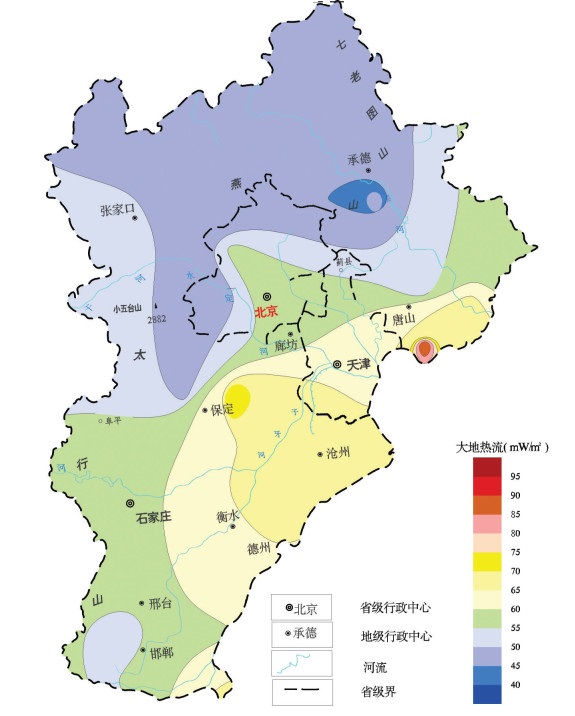
 下载:
下载:
